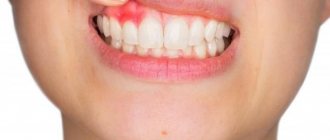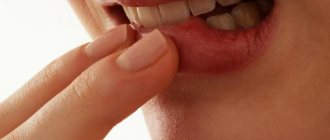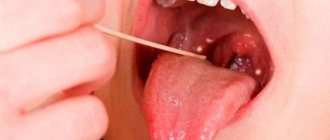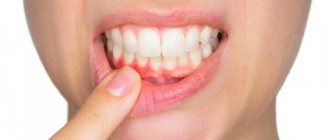Causes of swelling on the cheek
Many people believe that only teeth can provoke swelling of the cheeks. In fact, the reasons may be different.
Dental diseases
Factors related to oral health can provoke the problem. Among them:
- Eruption of impacted wisdom teeth, especially if the patient is over 25 years old. If the growth is abnormal, it is recommended to remove the “eight”.
- Stomatitis affecting the cheek, gums, tongue. The disease is most often diagnosed in children, but it can also occur in adults. An advanced disease provokes swelling. The cheek hurts from the inside, in the corner of the mouth.
- Gum disease, in which pathogenic bacteria accumulate in dental plaque, causing inflammation. Thus, gingivitis is accompanied by bleeding gums, swelling, and bad breath. If the disease is neglected, it will develop into periodontitis, a more serious problem.
Complications in the form of swelling of the cheek can develop after endodontic treatment. If during the procedure the canals are not washed and cleaned well enough, inflammation develops in the pulp chamber. The pathogenic process spreads to the bone, gum and cheek. This is how purulent periostitis develops, which is popularly called “flux”. If the disease is not treated in time, phlegmon and sepsis may develop, which pose a health hazard.
During the recovery period after tooth extraction, swelling of the cheek may also be observed. More often the symptom appears if the intervention was performed on the lower jaw. This problem often arises after implantation. This is the body's reaction to traumatic actions. It goes away in a few days. Otherwise, you need to consult a dentist, who must confirm or rule out the presence of a complication. It can develop due to infection getting into the wound, which threatens the manifestation of peri-implantitis.
Infectious, colds and other diseases
Cheek swelling is one of the symptoms of such diseases:
- Parotitis. When the disease occurs, the salivary glands become inflamed, which explains why soft tissues swell.
- Lymphadenitis. It occurs as an independent disease or as a complication of other ailments, such as diseases of the ENT organs. With lymphadenitis, the cervical, parotid and submandibular lymph nodes become enlarged, and the cheek becomes inflamed.
- Otitis, sinusitis, sinusitis. The inflammatory process can spread to the cheek, under the eye, and the area near the nose.
Pathological processes in gingival tissues often provoke inflammation of the salivary ducts and glands. It can also be an independent disease. It is caused by stones in the ducts, cysts, tumors.
The mucous membrane also swells with inflammation of the trigeminal nerve. In this case, other symptoms appear: numbness, pain radiating to the ear, “lumbago”. Swelling is a common occurrence in diseases of internal organs. Excess fluid due to malfunction of one or another organ accumulates in soft tissues, including the facial area.
Other causative factors
Swelling can also appear as a result of injury. This symptom accompanies soft tissue bruises, joint dislocations, and jaw fractures, which can be caused by a blow or fall. Children are more often susceptible to injury due to their excessive physical activity. Swelling can occur due to an allergic reaction, when the body shows immunity to a certain product. Other reasons:
- severe burn (both thermal and chemical);
- insect bites, which also cause redness and induration;
- poor oral hygiene.
Cheek swelling can occur in pregnant women. The fact is that during this period hormonal changes occur in the body. As a result, the gums swell, which is reflected on the cheek.
Treatment of pathology
What to do if there is a problem? After providing emergency assistance, the patient should consult a doctor. The specialist performs the necessary manipulations and then gives the patient recommendations regarding caring for the damaged area at home. These include mouth rinsing, physiotherapeutic procedures and local treatment of the soft tissues of the mouth. Providing emergency assistance for a cheek tumor is prohibited for children; women during pregnancy; adults who suffer from immunodeficiency; persons prone to allergic reactions.
General antibacterial drugs
Ideally, a suitable medication is prescribed after taking a swab from the mouth and identifying the causative agent of the problem. But if the situation is urgent, then to quickly eliminate the flux, the patient is prescribed new generation antibiotics. The action of the tablets is aimed at destroying and slowing down the spread of bacteria. For pathology use: Biseptol, Ampiox, Amoxiclav, Lincomycin.
Ointments
In addition to antibiotic therapy, topical medications are used. The use of products is permissible only with the permission of the dentist, since self-prescription of ointments rarely leads to recovery.
To reduce the intensity of the inflammatory process, Levomekol containing metaluracil and chloramphenicol is prescribed. Levomekol is rubbed into damaged membranes of the oral cavity 3-4 times a day. After treatment, you should not eat or drink water for 1 hour.
List of ointments that are used if a child’s cheek is swollen
To quickly get rid of the symptoms of swelling, you can use antimicrobial ointments in combination, for example, Streptomycin and Ichthyol. The drugs are mixed in equal proportions and applied to the damaged gum. Another popular drug of combined action is Metrogyl Denta.
Means for rinsing procedures
How to rinse the problem area? To quickly get rid of the remaining pus after surgery, and to prevent the development of swelling of the cheeks, use folk and household rinses. Several recipes are suitable for this purpose:
- Soda solution: 1 tsp. the main ingredient is dissolved in 100 warm water. Mouth baths are done at least 4 times a day.
- Miramistin. The drug is sold ready-made and does not require prior dilution. To treat foci of infection, take 20 ml of liquid into the mouth and rinse the mouth for 1 minute. After this, the liquid is spat out.
- Propolis solution. The drug is purchased at the pharmacy and diluted with boiled water in a ratio of 1:10. The product is used after meals.
- A mixture of St. John's wort, oak bark and sage: take 1 tsp. each ingredient and pour 500 ml of boiling water. The product is infused in a tightly closed container for 6 minutes. After filtering, the solution is used 3 times a day to relieve gum inflammation.
- A blend of green tea and sage. The dry collection is brewed with 500 ml of boiling water with the addition of 1 tsp. salt. The solution is recommended to be used warm. Before each procedure, it is advisable to prepare a fresh product.
- A mixture of chamomile, birch buds and calendula: the components are mixed in equal proportions and diluted with 1 liter of water. The mixture is boiled for 10 minutes, and then left to cool completely.
It is important to refuse the procedure in the first 24 hours after the intervention so as not to wash out the clot.
Symptoms of illness
Depending on the cause, symptoms may vary from case to case. More often with edema, the following symptoms appear:
- swelling on the cheek;
- pain in the causative area;
- difficulties in controlling facial expressions;
- inflammation of the mucous membrane.
It is important to monitor swelling. If it increases, medical attention is required. Reasons to urgently consult a doctor also include increased body temperature, general weakness, purulent discharge from the gums, loss of appetite, numbness and sagging cheeks.
Tip #1: go to the doctor immediately if you suspect purulent pathologies
If certain pathologies are detected, you should not hesitate to seek professional help, because This can lead to serious health problems, as well as the fact that you will have to say goodbye to a bad tooth forever.
So, your cheek is swollen from a tooth. What to do? First of all, try to understand what led to the problem. We list the reasons, if suspected, you should urgently go to the doctor:
- flux, or periostitis: due to this disease, according to statistics, most often the cheek, and not just the gums, swells greatly,
- fistula: a small lump with a hole in the gum through which pus oozes,
- alveolitis: occurs due to infection or injury to the wound of an extracted tooth,
- cyst: can develop next to a living tooth or be located near a pulpless tooth if there is a filling or crown on it,
- periodontitis: often a consequence of advanced pulpitis, or occurs in treated teeth if they have incorrectly manufactured and installed crowns, as well as in the case of poor-quality cleaning and treatment of root canals,
- osteomyelitis.
The photo shows the procedure for removing pus.
Click on the links on the names to read more about each disease. And if the symptoms are confirmed, then immediately go to the doctor, because... Without opening, draining and removing purulent masses, treatment will not bring positive results. Trying to help yourself at home will only waste valuable time and increase the likelihood of complications. The infection can quickly spread through the blood and lymph to internal organs and even cause sepsis.
Swelling of the cheek on the inside: what to do
How to remove swelling of the cheek? Depending on the degree of manifestation of the unpleasant symptom and the etiology, different treatment methods are used. Their success depends on the correct diagnosis.
When swelling occurs after dental implantation, ice should be applied to the sore cheek. You need to rinse your mouth lightly. It is important to maintain hygiene, diet and spare the postoperative wound.
Drug treatment
The doctor prescribes medications taking into account the clinical picture and the causes of swelling after a comprehensive diagnosis. You may need:
- "Miramistin" and "Chlorhexidine" - for rinsing;
- "Suprastin" is an antihistamine;
- "Nimesil" is an anti-inflammatory drug;
- “Amoxiclav”, “Lincomycin” are antibiotics that are prescribed for acute purulent periostitis.
How to relieve the pain accompanying the causative disease? Hexoral solution or spray or Lidocaine Asept aerosol can help. The painful syndrome in a child is relieved with the help of products that are used during teething, for example, Dentinox.
In some cases, conservative treatment is not enough, so surgical techniques are used. If there is suppuration, the doctor opens the gum, exposes the cavity with pus and installs drainage to drain the exudate. Surgery is also performed in the presence of a neoplasm.
First aid measures
What can you do at home to reduce the intensity of the symptoms? If the gums are swollen, but the condition is not accompanied by a general deterioration in the condition: a rise in temperature and signs of intoxication, then first aid measures can be carried out.
How to remove a tumor? First aid includes the use of various herbal remedies to rinse the mouth. For this purpose, chamomile, St. John's wort, and oak root are used. Herbs will relieve inflammation and stop the proliferation of pathogenic flora in the mouth. The procedure is performed every 2 hours for 1-2 minutes.
Instead of herbal decoctions, antiseptic drugs are used - Stomatodin, Chlorophyllipt. The drugs are diluted with warm water and rinsed with them every 3-4 hours.
Chlorophyllipt is used in dentistry for exacerbation of infectious diseases
What should not be done if the gum area is swollen? If a tumor occurs, they refuse to heat the problem area. This leads to a worsening of the situation and further spread of the pathological process.
If your tooth hurts badly and your cheek is swollen, take anti-inflammatory drugs - Nise, Nurofen, etc. Analgesics – Solpadeine and Ketanol – can help relieve swelling well. The latter remedy has many side effects, but can cope with any type of pain. If a child’s cheek is swollen, then preference is given to anti-inflammatory drugs in the form of syrup.
What not to do if your cheek is swollen
Before removing the swelling, so as not to worsen the situation, you need to understand what can be done and what cannot be done. If you are not sure of the cause of the swelling, you do not need to apply any compresses, neither warm nor cold, before visiting the doctor. Such actions are fraught with negative consequences. For example, when pus forms, a hot compress can accelerate the development of the pathological process. It is not even recommended to sleep on the sore side. You should also not disturb the swollen cheek, press or massage it.
You should not take painkillers immediately before your visit to the doctor. It can obscure the clinical picture and complicate the diagnosis. It is also prohibited to use any medications without a doctor’s prescription and supervision, especially antibiotics, which affect not only the cause of the disease, but also the entire body.
Tip #5: Avoid activities that cause blood flow to the head
Blood rushing to the soft tissues in the facial area increases pressure on the sore area, increases discomfort, increases swelling, and increases the spread of bacteria. To make the swelling of the cheek less significant and painful, we will tell you how to act. Of course, it will not be possible to remove it completely, but it will be possible to reduce the intensity of the unpleasant sensations.
First, temporarily exclude from your diet foods that increase blood circulation: hard and hot, spicy and salty foods. Avoid drinking caffeinated and alcoholic drinks. Try not to drink too much, because... this provokes internal swelling of the tissues. You should also chew food on the side of the jaw that is opposite to the swollen side, so as not to further injure the tissue.
Avoiding coffee helps reduce swelling
Secondly, try to keep your head upright. To do this, use a high pillow when sleeping or resting.
Thirdly, reduce physical activity and avoid sports while swelling of the cheek is present. Also avoid visiting saunas and steam rooms, beaches (on hot sunny days), and do not take a hot bath. And, of course, give up such a bad habit as smoking.
Notice
: Undefined variable: post_id in
/home/c/ch75405/public_html/wp-content/themes/UltraSmile/single-item.php
on line
45 Notice
: Undefined variable: full in
/home/c/ch75405/public_html/wp-content /themes/UltraSmile/single-item.php
on line
46
Rate this article:
( 4 ratings, average: 5.00 out of 5)
toothache
- Minaeva N.V. Modern strategy for antibacterial therapy of upper respiratory tract infections in children in outpatient practice / Medical Council. – 2022.
Expert “Before treating or removing a tooth, or any other surgical procedure, an experienced dentist must find out whether the patient has diseases or allergic reactions to medications that can lead to swelling. If a person suffers from hypertension (high blood pressure) or has problems with blood clotting, then the likelihood of developing edema increases sharply. The doctor’s task is not only to warn the patient about possible consequences, but also to minimize the risk of their occurrence with the help of supportive drug therapy.” Dental hygienist Victoria Nikolaevna Kashaeva
Consulting specialist
Kashaeva Victoria Nikolaevna
Specialization: Dental hygienist Experience: 8 years
How to prevent cheek swelling: preventive measures
To prevent the manifestation of an unwanted symptom, you must follow certain recommendations:
- Maintain good oral hygiene. It is especially necessary to monitor the child’s performance of all procedures. It is important to brush your teeth twice a day, use dental floss and mouthwash.
- Visit the dentist periodically - at least twice a year. If unpleasant symptoms occur, a visit to the doctor should be made immediately.
- Strengthen the gums and roots of the teeth by rinsing with herbal infusions and eating solid plant foods.
- Eat rationally and balanced. The body must receive the entire complex of vitamins and minerals around the clock.
No one is immune from problems, but preventative measures will help reduce the likelihood of their occurrence.
Prevention
The main procedure for preventing cheek swelling is timely treatment of caries and other dental problems.
Simple recommendations will also help maintain oral health:
- Regular dental care. Dentists advise using more than just a brush and paste. To effectively clean your mouth from plaque, you can use dental floss, floss and irrigators. You should also not forget about cleaning your tongue, since most of the bacterial flora is concentrated there.
- Pay attention to the condition of your gums. If these structures are loose and bleeding, they turn to a specialist - a periodontist.
- Visit your dentist at least once every 6 months for a diagnostic examination and professional teeth cleaning.
- Change your eating habits. Carbonated drinks, sweets and alcohol have a detrimental effect on the condition of teeth and enamel. To maintain dental health, it is better to consume fermented milk products, fresh vegetables and fruits.
Swelling of the cheek should not be ignored; in addition to aesthetic problems, the condition can threaten human health. More often, the problem develops against the background of developing caries and improperly performed dental work. If the inflammation is not accompanied by bleeding, fever and other dangerous signs, then emergency measures are taken at home, and then see a dentist. Preventive methods regarding cheek swelling are simple and accessible to every person. Their implementation will minimize the frequency of visits to the dentist.
Comments
Just a week ago I had a routine examination at the dentist, they took an X-ray of my jaws... the doctor did not find any problems. There was nothing to treat. A day ago my cheek was swollen, but there was no toothache. With what it can be connected? Maybe the doctor made a mistake?
Dina (12/23/2019 at 05:32 pm) Reply to comment
- Dear Dina, sometimes swelling of the soft tissues of the face can be associated with diseases that have nothing to do with teeth. For example, this phenomenon occurs with ENT pathologies, otitis media, tonsillitis, sinusitis, and sinusitis. First, seek help from a therapist.
Editorial staff of the portal UltraSmile.ru (12/28/2019 at 09:14) Reply to comment
what should I do if my cheek is swollen due to a tooth and I am 13 years old but the tooth does not hurt
Nastya (05/09/2020 at 14:29) Reply to comment
I have clean canals in my tooth, but the pain is terrible when tooth comes into contact with tooth, and the gums are swollen, the doctor prescribed an antibiotic, if that doesn’t help, then remove the tooth)) funny)) if they see that the tooth is no longer viable, why bring my condition to constant pain for 5 days?
Irina (09/03/2021 at 20:52) Reply to comment









